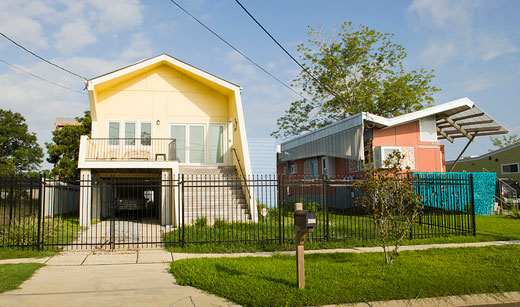
NEW ORLEANS – In August 2005, people in the Lower Ninth Ward evacuated their homes hours before Hurricane Katrina destroyed them. They were part of an exodus of more than one million other New Orleans residents that scattered across the nation as a result of the storm.
Six years later people are sitting on the porches or tending gardens next to a handful of state-of-the-art “green” homes that sit here in the Lower Ninth where their old houses once stood.
These are the “Make it Right” houses constructed with seed money put up by Hollywood superstar Brad Pitt. Some of the gleaming new structures sit opposite desolate, abandoned lots while others are sandwiched in between crumbling houses to which no one has returned. Pitt hopes to eventually see 150 of the new homes constructed in the Lower Ninth Ward.
The actor fell in love with New Orleans in 1994 when he filmed “Interview with a Vampire” here and, two years after Katrina, he and Angelina Jolie purchased a home in the city’s French Quarter.
Pitt and a partner put up $5 million apiece in seed money and then solicited much more in donations. Twenty-one architects donated their time and services to designing the new “green” homes, which are among the most energy-efficient in the region. Some are outfitted with solar panels.
“The people in these Brad Pitt houses,” said, Reginald Johnson, a New Orleans resident who evacuated like so many others, “are living now in beautiful homes that they were able to purchase for maybe $150,000 or so, but, unlike many other people who lived here before the storm, they had to have something to start with.”
Johnson himself was more fortunate than many others. During the storm his own home took in only a few feet of water and suffered roof damage. He returned within days of the hurricane and, with a boat that he “commandeered,” began rescuing people who were still trapped.
“If an individual got $40,000 for his or her destroyed home he or she still had to borrow in order to make down payments on the Brad Pitt houses. Lack of jobs for potential returnees makes it impossible for most folks to make regular payments on new homes,” Johnson said.
“Don’t get me wrong,” said Chet Held, president of a large building trades union local here. “I have great respect for all the people who came down here to volunteer, donate and help us rebuild, but it hasn’t always been the right type of help.”
Held, who is president of International Brotherhood of Electrical Workers Local 130, explained that local unions wanted builders of the Brad Pitt houses to hire local union members, or at least local people at union wages so that the building project could revitalize the local economy.
“They were looking for just volunteers,” said Held, “when what the area really needs is good paying jobs. The whole neighborhood needs to be rebuilt and what we need is a large government program or a government-business partnership. You want the rebuilding to benefit people in the area. You gotta put some money into the pockets of the people.”
As People’s World reporters toured the Lower Ninth Ward the problems cited by Held and Johnson were evident everywhere. Six years after the storm, less than 20 percent of the neighborhood is inhabited.
Across from one row of Brad Pitt houses was an entire flattened and desolate block.
“They had a Marshall Plan to rebuild Europe after the war,” Johnson said. “That’s what we need here. This has gone on too long. A few projects here and there aren’t going to do it.”
“What do you do when you live in a nice house and all around you it’s a ghost town?” asked Johnson. “Kids used to run up and down this street,” he said, as we passed an empty field that was a school before Katrina. “No more children, no more school, they’re all gone. We are waiting for them to come back, we’re hoping and praying that they will come. We are hoping and praying that all our friends come back.”
Photo: Colin Gray/PW










